Hibiscus is a tropical plant, so most people bring it indoors in winter as it cannot tolerate cold weather, especially the Tropical Hibiscus species. But what to do if your Hibiscus was outside and has frozen? Let’s find it out.
If your Hibiscus froze, turn on sprinklers to let the plant be covered with ice for insulation, use Growth Enhancer, and wait till spring to prune the damaged leaves and dead branches. Take the potted plants indoors, add mulch around the outdoor plant base and cover it with frost cloth.
There are many things to understand about this subject. In this article, I will share Hibiscus cold tolerance, identify freeze damage, deal with a frozen Hibiscus, and some winter care tips.
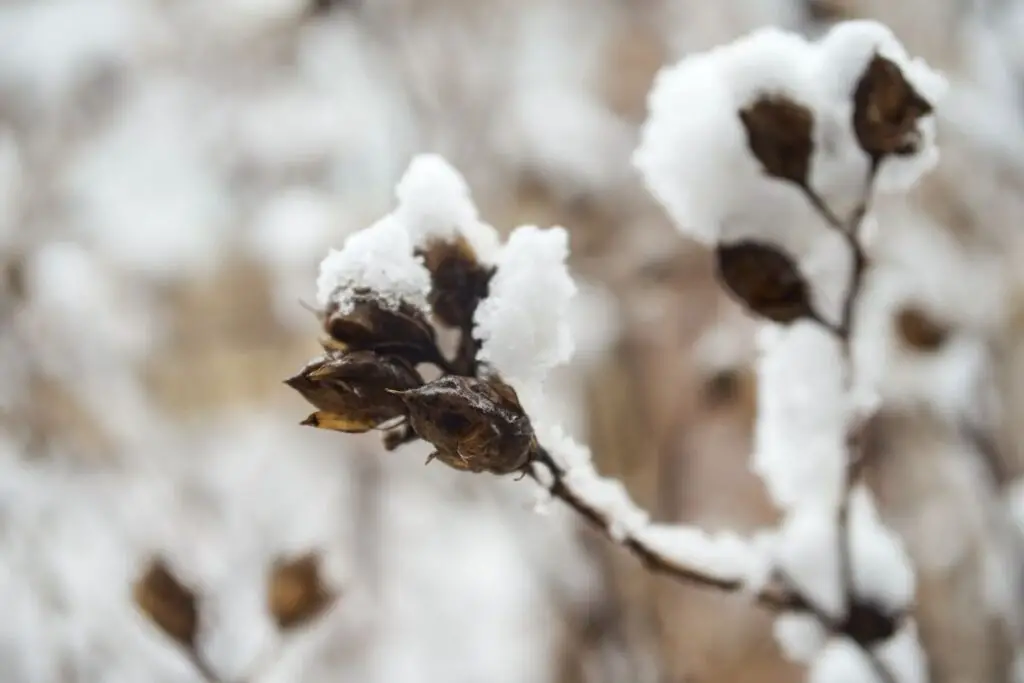
Hibiscus plant freezing
Hibiscus plants belong to tropical regions.
They enjoy growing around warm temperatures, high humidity, and sunny weather.
That is why they are intolerable to cold weather and freeze if exposed to low temperatures for a long time.
There are two types of Hibiscus – Tropical Hibiscus and Hardy Hibiscus.
Tropical Hibiscus plants are native to warm climatic areas with zones 9 to 12.
They don’t accept temperatures below 50°F.
They need to be brought indoors if grown in colder zones.
Hardy Hibiscus plants are from zones 4 to 8, and they can endure temperatures as low as -20 to -30°F.
They can stay outdoors in colder climates.
Whatever variety you grow, if your region receives frost and you grow them outside, Hibiscus will receive freeze damage.
How do I identify a frozen Hibiscus plant?
There are two types of cold damage – frost damage and freeze damage.
The difference lies in the amount of damage received.
Frost happens when the temperature goes below 32°F, and the cold air remains trapped in the ground.
Hibiscus loses the moisture, warms up the above air, and causes ice crystals on the leaf surface.
This moisture will freeze when the temperature goes below 20°F, causing freeze damage.
To identify a frozen plant, look out for the following signs:
- Wilted leaves with brown-purplish to black color
- Flower buds look wilted and slimy
- Tips of the branches wilt and die
What should I do with a frozen Hibiscus plant?
Be it a Tropical Hibiscus plant or a hardy variety, if it is frozen, don’t panic or don’t get tempted to prune off the damaged leaves and stems immediately.
If your plant has frozen, you can take the following steps to help it come back after the winter:
Looking for gardening supplies? We have tested 100's of products before recommending them to you guys. Check out our best pick below:
| Image | Gardening Supplies | Best Price? |
|---|---|---|
 Top
Top Top
Top | Raised Garden Bed Kit | Check On Amazon |
 | XLUX Soil Moisture Meter, Plant Water Monitor, Soil Hygrometer Sensor for Gardening, Farming, Indoor and Outdoor Plants, No Batteries Required | No Results |
 Top
Top Top
Top | 82 Pcs Garden Tools Set and Extra Succulent Tools Set | Check On Amazon |
 | Joeys Garden Expandable Garden Hose with 8 Function Hose Nozzle, Lightweight Anti-Kink Flexible Garden Hoses, Extra Strength Fabric with Double Latex Core, (50 FT, Black) | No Results |
 Top
Top Top
Top | Dual Chamber Compost Tumbler | Check On Amazon |
 Top
Top Top
Top | Sunnyglade Plant Stakes | Check On Amazon |
 Top
Top Top
Top | Organic Cold Pressed Neem Seed Oil | Check On Amazon |
 Top
Top Top
Top | Mighty Mint Gallon :-Insect and Pest Control Peppermint Oil | Check On Amazon |
 Top
Top Top
Top | Scotts DiseaseEx Lawn Fungicide | Check On Amazon |
 Top
Top Top
Top | Jacks Classic 20-20-20 All Purpose Fertilizer | Check On Amazon |
 Top
Top Top
Top | 30,000 Seeds Pollinator Attracting Wildflower Mixture | Check On Amazon |
 Top
Top Top
Top | Survival Vegetable Seeds Garden Kit-Over 16,000 Seeds | Check On Amazon |
Provide warmth
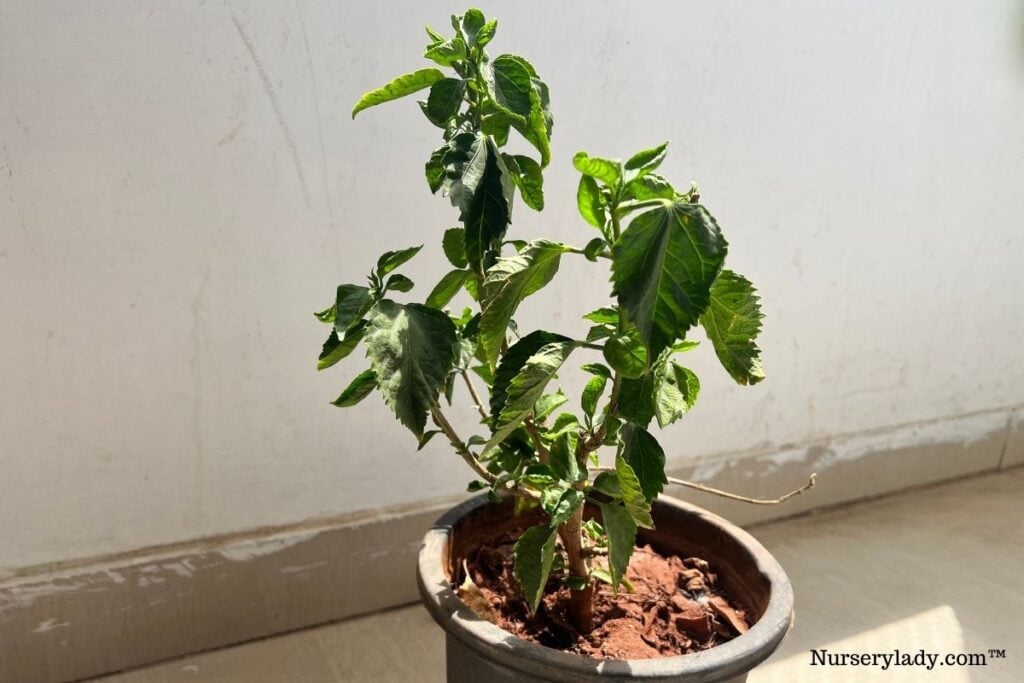
Bring them indoors if your plant is outside and still did not get knocked by the freeze.
Add an 8-inch layer of mulch for grounded plants and cover them with a frost cloth.
If the plant is uncovered and frozen, turn on your garden sprinklers and keep them on overnight.
The sprinkler should be kept on high enough so that the plant gets completely drenched.
The plant is already frozen.
The water from the sprinkler will freeze them more.
The next morning, you will find your plant is completely covered with ice.
Don’t panic when you see your plant white with ice.
Let it stay like that.
The ice will help insulate the plant and provide the warmth they need in a freeze.
Also read: Can Hibiscus Tolerate Cold Weather? (+Winter Care)
Use Growth Enhancer and stop watering
Growth Enhancer can work brilliantly for your frozen plants.
It will help the frozen plant to defend against any sickness or stress.
Fertilize your plant in winter with a liquid fertilizer, not slow-release.
Even if the plant is not growing, the roots are still growing for now.
So, they need some encouragement to continue growing.
The more roots your plant will have, the more your plant’s upper parts will develop when spring arrives.
Using Growth Enhancers and fertilizer will also help the plant come out of dormancy in the spring.
When the plant is frozen, it will die if you give it lots of water, like in spring or summertime.
Freeze forces the plant to become dormant.
During this time, the plant doesn’t absorb water much.
It is best to water it in bits only to ensure moist soil.
Again give water when the provided water is fully used.
Also read: How To Water Hibiscus Plant? (How Much, How Often & More)
Wait for the spring.
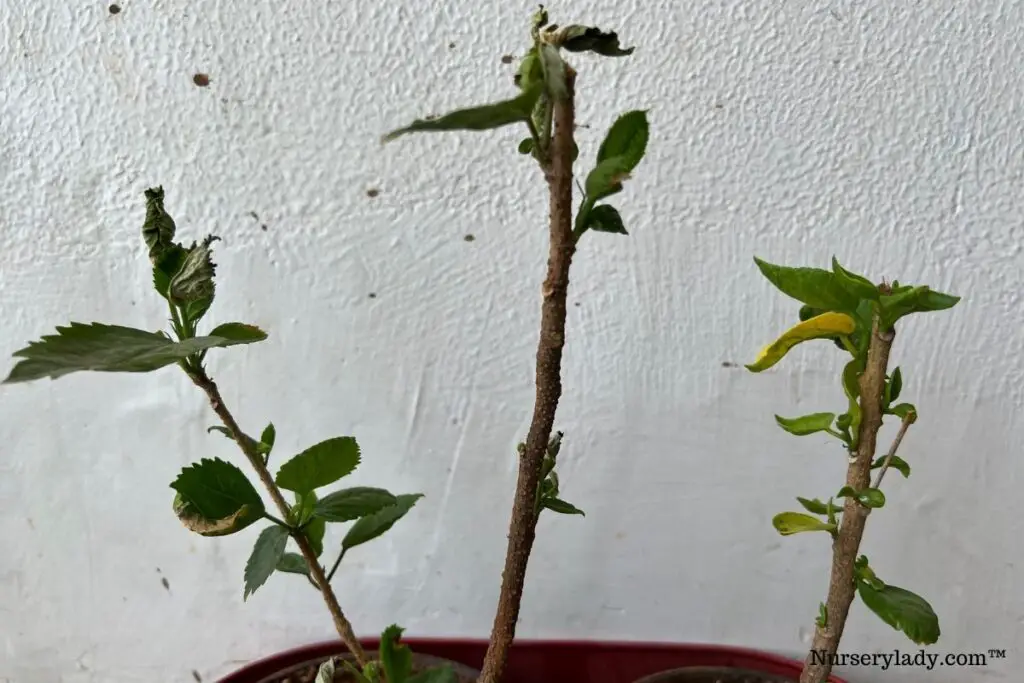
When the plant freezes, it is quite tempting to remove the frozen or damaged parts from the plant, like the wilted leaves, flower buds, or stems.
But wait.
Control your urge to prune the damaged and dead parts off until the spring arrives.
When spring arrives, it is time to clean up the frozen plant.
Cleaning the frozen plant means you have to prune off the damaged parts of the plant and prepare it for spring development and blooming.
While pruning the Hibiscus plant, wear gloves and always prune with sharp pruners and not with hands.
Keep water-free, hand cleaner, and plastic near you. You have to sterilize the pruners after every cut.
Collect the dead, damaged and diseased parts into the plastic and not in the ground.
Also read: When Do Hibiscus Bloom? (+How Long Does A Hibiscus Bloom Last)
Find the live wood
The stems of the Hibiscus plant will die after frozen.
But not all the stems will die. Some will remain alive.
To identify this, you have to scrape the outer bark of the stem around 1/4th or ½ inches to expose the inner layer.
If the inner layer is brown, that part of the stem is dead.
Some branches will be soft and squishy.
You don’t have to test them as they are already doomed.
Continue to scratch and expose the inner layer until your find a green inner layer.
A stem with green color underneath means that part of the stem is alive.
This part is called live wood.
The parts with a mixture of brown and green color will also probably die after some days.
So, don’t consider that part of being the live wood.
Once you find out where the brown inner layer stops and the bright green layer starts, it is time to prune the dead stems.
Remove the deadwood
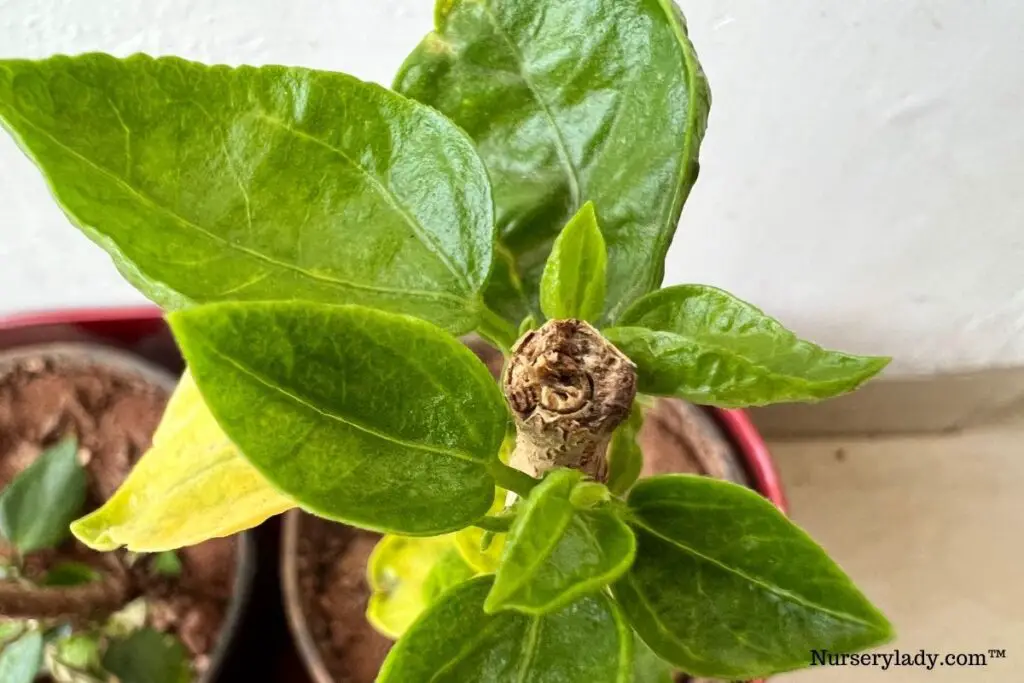
There are two techniques to follow while pruning the dead stems.
It will give you a successful pruning.
- First, you need to find the highest spot of the living wood, which means the part from where the stem will have only a bright green inner layer and no browns.
- Once you find the highest mark, find a leaf node down to the highest spot and cut the stem ¼ inch above that leaf node.
- It will help eliminate all the dead woods and prevent any diseases from spreading.
- When you cut the stem, check that the inner core of that stem is clear white. If not, move downwards and continue cutting another stem above the leaf node until the white inner core is found.
- Ensure that the new stem growth occurs close to the leaf node or 2-3 nodes below the cut.
The second strategy is to remove the dead woods and shape the plant.
- Continue finding the highest spot of the live wood.
- Here, cut more downwards above the node pointed in the direction you want the stem to grow and not above the very first node of the live wood.
- Some removed stems will have white inner cores. Cut ¼ inch above the leaf node to give the stem space to grow.
- If the cut is made too high, the remaining wood will rot. If you have cut very close to the node, remove some plant cells sprouted in the new branch.
In this method, more woods require pruning than in the first method.
This type of pruning is also called hard pruning.
This pruning will encourage the plant to grow more stems to give the plant a bushy appearance in the spring and summer.
2/3rd parts of the plant will require pruning in the second strategy.
Since spring and summer are their growing season, they will re-grow more branches and look fuller than before.
There will be some twigs in the dead woods.
Remove them as well during pruning and dispose of them in the dustbin.
Also read: Is Hibiscus An Indoor Or Outdoor Plant?
Will Hibiscus come back from a frozen condition?
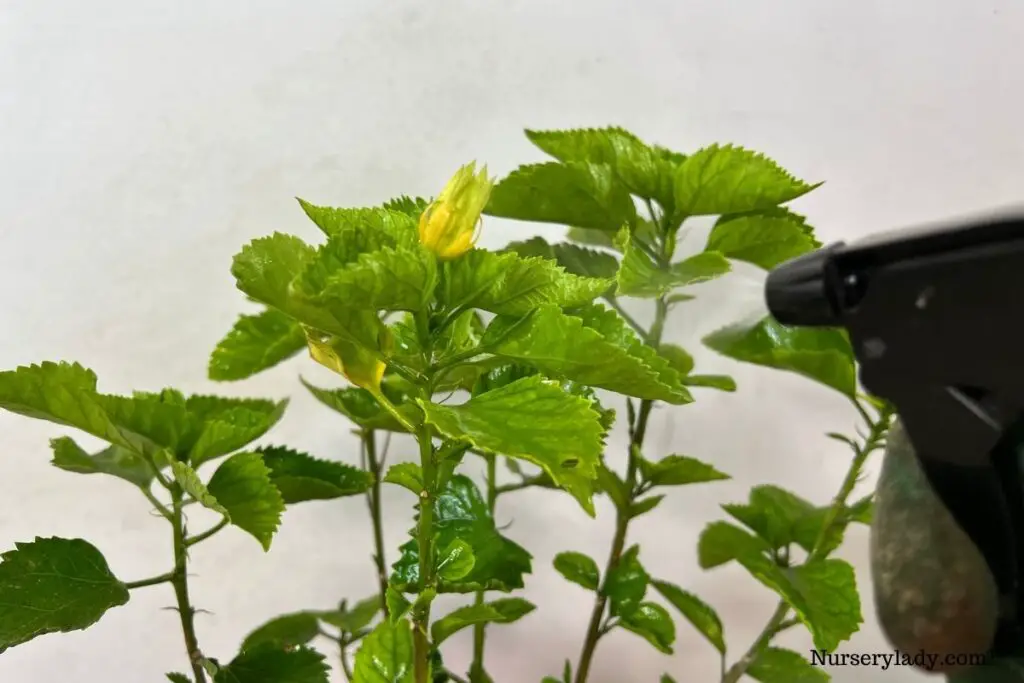
Generally, Tropical Hibiscus should be taken indoors in winters if your region gets frost or temperature drops below 32°F or 50°F at night.
You can keep Hardy Hibiscus outside.
If, however, your plant gets freeze damage, don’t worry.
It won’t die if you follow the instructions shared previously. Only then will the plant come back from the freeze.
As mentioned earlier, the plant will require pruning after spring as they are frozen outside.
Removing the damaged parts will encourage the plant to grow more stems and make the plant full.
Once you have done pruning, you need to bring it back from dormancy.
The freeze will force the plant to become dormant.
Depending on the weather and growing conditions, it will take weeks to come out of dormancy.
Maintain consistently moist soil and continue to use Growth Enhancer and fertilizer.
You can use a product, Wake-Up Spray, to encourage the plant to awaken from hibernation.
Use it daily until new growing tips are seen.
After that, use it once per week for more 2-3 weeks.
Then stop using and apply only the Growth Enhancer and fertilizer.
Once the temperature warms up, your plant will be green again.
Start regular fertilizing and watering.
Let it have enough sunlight and start a regular care routine for profuse blooming in the spring and summer.
Also read: How To Prune Hibiscus? (A Step-By-Step Guide)
What can I do to prevent Hibiscus from freezing?
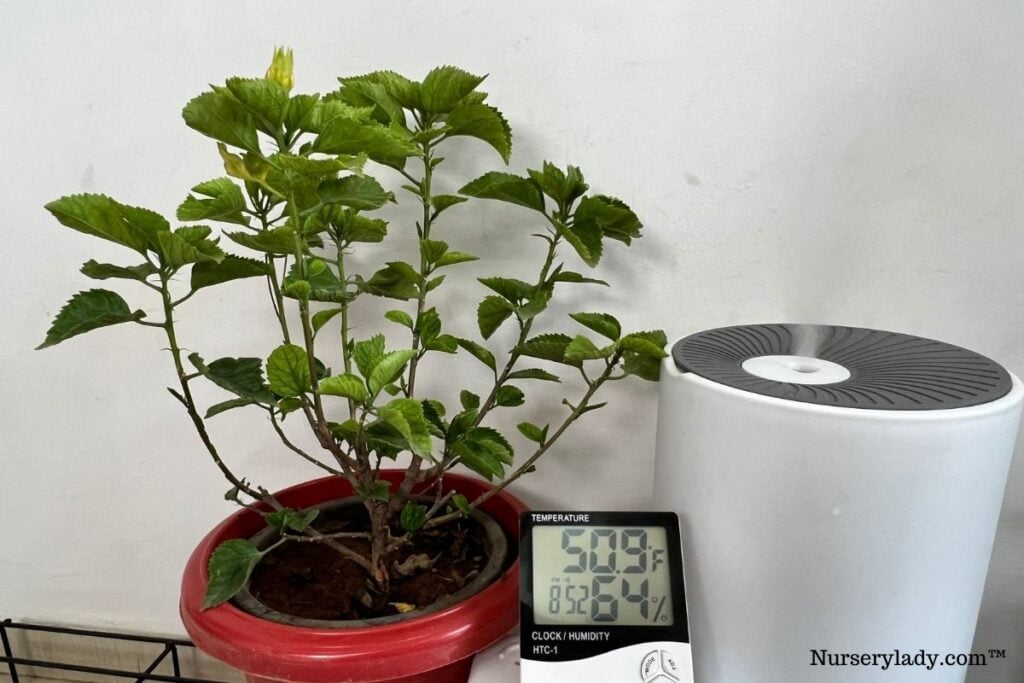
If you don’t want your plant to get frozen in winters, you need to follow some winter care tips to help your plant overwinter.
- If you are growing a Tropical Hibiscus plant in colder regions that gets frost, grow it in a container and bring it indoors in the fall. Sometimes, some areas get early frost in the fall. So, know about it and bring the plant inside before the frost.
- Indoors, maintain a temperature range of 60-65°F and 50-70% humidity levels. Keep the plant near a sunny window for warmth. Use artificial light and humidifier if required.
- It might not let the plant become dormant. But, if it does, stop watering and fertilizing, keep it inside in a dark place, and bring it out when the weather warms up. Expect new growth in February or March.
- Let it remain outside if your region receives tolerable winter for your Hibiscus. It can be for both Tropical and Hardy Hibiscus plants, provided you grow them in their ideal zones.
- While keeping Hibiscus outside, protection from freeze damage is necessary.
- Add a thick, 8-inch layer of compost as mulch around the plant base when the temperature cools down. This mulching will trap the moisture and warmth in the soil and won’t let the cold temperature reach the roots.
- Cover the plant with a frost cloth in the evening to prevent the frost from reaching and damaging it. Let it have sunlight in the morning.
- If possible, fix some Christmas lights inside the cloth to maintain a warm temperature for the plant.
- Your plant will become dormant if kept outside. Besides, Hardy Hibiscus will die to the ground and again come back when the temperature warms up.
Final thoughts
A frozen Hibiscus plant doesn’t mean you can’t save your plant. With the right steps, your plant will be safe. If you find that your plant has frozen, switch on sprinklers to soak your plant so that it gets covered with ice the next day. It will insulate the plant.
Wait for the spring to appear for pruning the damaged parts. Don’t prune in the winters. To prune the dead branches, find out the high point of live wood and remove the remaining dead woods.
Mulch the plant base and cover the plant with frost cloth when winter is about to arrive. You could do the same if your plant remained uncovered outside and already received slight freeze damage. It will also warm them up and save them from further damage.
Don’t water your plant too much in winter. Continue using Growth Enhancer and fertilizer because the plant may stop growing, but the roots won’t. Using these products will help the plant to come out of dormancy faster.
Reference: Wikipedia, ASPCA, Louisiana State University Agricultural Center, American Society for Horticultural Science, Tropical Hibiscus by Texas A&M University, Sciencedirect.
